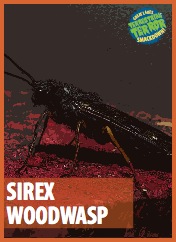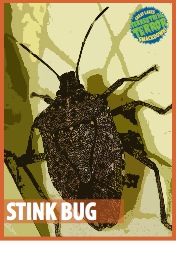Editor’s note: Great Lakes SmackDown Terrestrial Terror is an ongoing Great Lakes Echo series. Brackets can be filled out until Friday, March 18. Find more information here.
By Alice Rossignol and Rachael Gleason
They stink, they sting and bore holes — it’s time for the insects to fight the battle of the bug.
EMERALD ASH BORER vs. SIREX WOODWASP
First to square-off, all the way from Asia, is the Emerald Ash Borer, or “The Green Menace.” This shiny plated insect is a professional ash tree killer. It bores through the bark, messing up the tree’s system which leads to certain death! Also from across the globe, the Sirex Woodwasp, also known as, “Miley Cyrex,” also drives through tree bark. It injects toxic mucus and eggs that interact to successfully murder it. We hope this match doesn’t “bore” you to death.
Fighter Profiles:
 Alias: Green Menace
Alias: Green Menace
Legal name: Agrilus planipennis
Home Turf: Eastern Russia, northern China, Japan and Korea
U.S. Fighting Debut: June 2002 (Michigan)
Agent: Ash trees; affects woodlots and landscaped areas. Spreads when people move ash firewood and logs out of a quarantined area.
Preferred Great Lakes fighting arena: All eight Great Lakes states and two Canadian provinces.
Weight/Size class: 1/2 inch-long and 1/8 inch wide
Fighting Skills:
- Ash trees better watch their behinds with this nasty invader. This tiny green beetle bores into ash trees, disrupting the transport of water and nutrients throughout the tree.
- Borer infestations cause foliage to wilt, branches to die; heavy infestations thin out urban tree canopy and kill off mature ash trees, which can lead to temperature changes and increased air pollution.
- The emerald ash borer is a money suck. Infestations economically burden homeowners, who must remove and replace dead ash trees.
Life Expectancy: About one year.
Offspring: Roughly 60 to 90 eggs per female.
 Alias: Miley Cyrex
Alias: Miley Cyrex
Legal name: Sirex noctilio
Home Turf: Europe, Asia & Northern Africa
U.S. Fighting Debut: 2004
Agent: Accidentally introduced through wood imports.
Preferred Great Lakes fighting arena: Indiana, Michigan, New York, Pennsylvania, Ontario
Weight/Size class: 1 to 1.5 inches in length.
Fighting Skills:
- This creepy flier pines for a variety of pine trees and can bore through bark. They’ve also been known to feed on various larch and fir trees.
- Once a hole is drilled this wasp injects toxic mucus, a fungus called Amylostereum areolatum and her eggs.
- Once wounded, trees show signs such as reddening needles and resin beads pouring out of the bored wounds. Eventually they die.
Life Expectancy: About 1 year
Offspring: Each female wasp lays between 25 and 450 eggs.
Gypsy Moth vs. Brown Marmorated Stink Bug
In the other ring: the Gypsy Moth. Gypsy moth larvae are highly destructive to hundreds of types of trees, especially oak. In this caterpillar form they are voracious consumers of leaves, earning this fighter the title of “The Extreme Defoliator.” Just downwind lurks the Brown Marmorated Stink Bug, known to other insects as “The Stale Wind.” This stinky insect hails from Asia and destroys fruits and vegetables. It is also known to enter buildings and houses in mass, leaving no stench behind (if you’re lucky).
 Alias: The Extreme Defoliator
Alias: The Extreme Defoliator
Legal name: Lymantria dispar
Home Turf: Europe and Asia
U.S. Fighting Debut: 1860s
Agent: An agent named E.L. Trouvelot brought the moths from France to conduct silkworm research. The moths escaped and the invasion began.
Preferred Great Lakes fighting arena: Minnesota, Wisconsin, Michigan, Indiana, Illinois, Ohio, Pennsylvania, New York, Ontario, Quebec.
Weight/Size class: Adult form: Males: 1.5 inch wingspan. Females: 2-inch wingspan. Caterpillar form: 1.5 to 2 inches long.
Fighting Skills:
- This insect is most lethal in its voracious caterpillar form. It feeds on the foliage of hundreds of types of trees, with a preference for oak.
- This feeding habit can lead to complete defoliation of trees and combined with other factors can cause DEATH.
Life Expectancy: About 1 year
Offspring: A female lays 50 to 1,000 eggs in each year. Eggs can be spread by “hitchhiking” where eggs are laid on moving objects like vehicles.

Alias: The Stale Wind
Legal name: Halyomorpha halys
Home Turf: Eastern Asia
U.S. Fighting Debut: First documented in Pennsylvania in 1998.
Agent: Most likely an accidental arrival in shipping crates of Asian imports.
Preferred Great Lakes fighting arena: Minnesota, Wisconsin, Michigan, Illinois, Indiana, Ohio Pennsylvania and New York.
Weight/Size class: This one’s adults are about 1 inch long.
Fighting Skills:
- This stinky insect is known to putt-putt around and damage host plants like: ornamental plants, fruit trees and vegetables. Damage includes forming wart-like growths on beans and puckering or pitting of fruit.
- These guys like to hang out together in the fall and may form large congregations on buildings or invade your home!
- As its name implies, it releases a foul, stale wind-like odor when it feels threatened.
Life Expectancy: Usually one generation per year.
Offspring: Each female lays up to 250 eggs after mating, which hatch in 4 to 5 days.
Which insect will bore or stink their way through the competition? Cast a vote and convince others of your selections in the comments below.